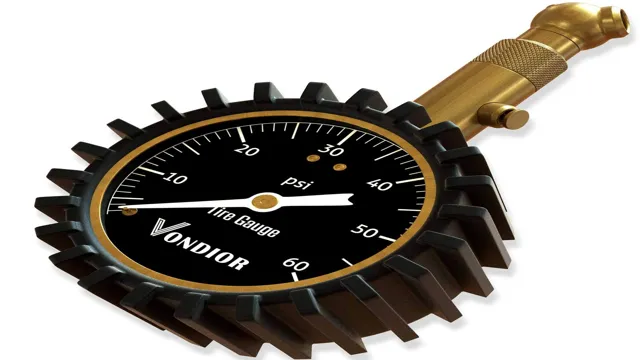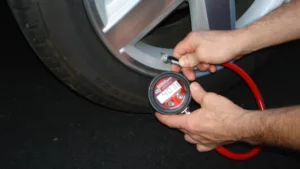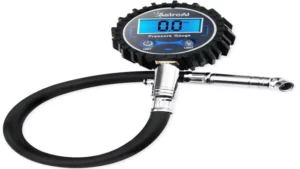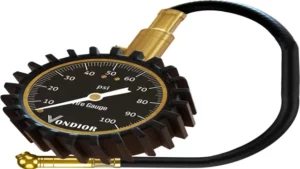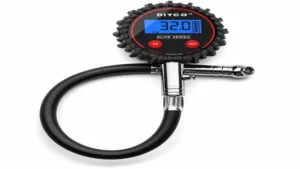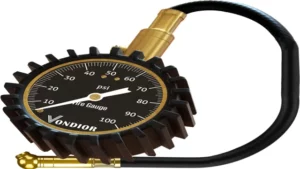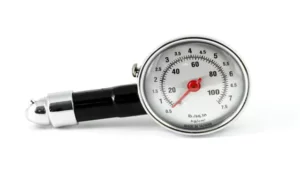Have you ever wondered if your tires are properly inflated? It’s essential to maintain the correct tire pressure in your vehicle for better fuel efficiency and overall safety on the road. But how can you tell if your tires are properly inflated? The answer lies in the tire pressure gauge reading. Think of the tire pressure gauge as a thermometer for your tires.
It measures the amount of air pressure inside your tires and displays it on a gauge. Knowing how to read the tire pressure gauge is crucial in ensuring that your tires are properly inflated. Similar to how you would check your body temperature with a thermometer, you must check your tire pressure regularly.
Not having the correct tire pressure can cause uneven wear, instability, and other tire-related issues. Additionally, it can affect your vehicle’s fuel economy and put you at risk of a potential accident. So, how do you check the tire pressure gauge reading? It’s quite simple and can be done with a few basic steps.
Follow them regularly, and you’ll be a pro at maintaining the right tire pressure. In this blog post, we’ll dive deeper into the importance of tire pressure, understanding the tire pressure gauge reading, and the steps to take to maintain the correct tire pressure. Stick around and learn how to keep your tires in top condition for optimum safety and performance.
Why Proper Tire Inflation is Important
Proper tire inflation is crucial for several reasons, and it’s important to know what a tire pressure gauge should read to maintain optimal tire performance. First and foremost, overinflated tires can cause uneven wear on the tire’s tread, resulting in a shorter lifespan for the tire and reduced tire grip on the road. On the other hand, underinflated tires can lead to reduced fuel efficiency, increased stopping distances, and even potential blowouts.
The ideal tire pressure can vary depending on the make and model of the car, but typically falls between 30-35 PSI. To ensure the safety and longevity of your tires, it’s essential to regularly check and maintain the correct tire pressure using a reliable tire pressure gauge. So, if you’re wondering what a tire pressure gauge should read, aim for the manufacturer’s recommended PSI and adjust accordingly based on your driving habits and conditions.
Safety
Proper tire inflation is crucial for safe driving and vehicle performance. Driving on underinflated tires can cause a variety of problems, including reduced fuel efficiency, increased tire wear and tear, and decreased handling and stability. On the other hand, overinflated tires are more prone to punctures and are often less comfortable to drive on.
Additionally, incorrect tire pressure can lead to blowouts or tire failure, which can be dangerous and potentially life-threatening, especially at high speeds. That’s why it’s essential to check your tire pressure regularly and ensure that your tires are inflated to the recommended level. By doing so, you’ll not only improve your safety on the road but also extend the life of your tires, save money on fuel, and enjoy a smoother, more comfortable ride.
So, take a few moments to check your tire pressure before hitting the road and enjoy a safer, more enjoyable driving experience.
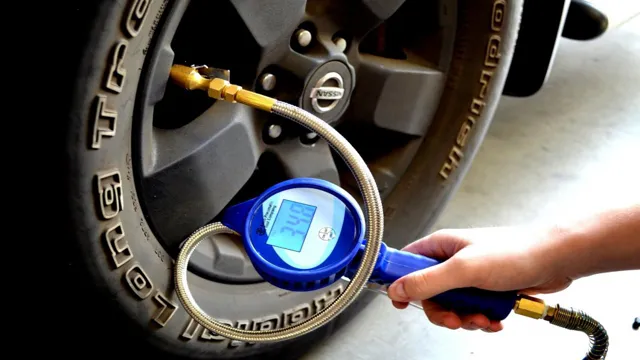
Better Fuel Economy
Proper tire inflation is a crucial aspect of improving your car’s fuel economy. When tires are underinflated, it creates more surface area contact with the road, which in turn creates more resistance. This additional resistance means that your engine has to work harder to move your car forward, which leads to higher fuel consumption and lower MPG.
Additionally, underinflation can increase wear and tear on the tires, leading to a shorter lifespan and more frequent replacement. On the other hand, overinflation can also negatively impact your fuel economy by causing the center of the tire to bulge out, creating less surface area contact with the road. This can lead to a more uncomfortable ride and reduced traction.
Checking your tire pressure regularly and keeping your tires at the manufacturer’s recommended psi is an easy and effective way to improve fuel efficiency, extend the life of your tires, and save you money in the long run. Don’t forget – every pound of pressure counts!
Tire Life
Proper tire inflation is key to extending the life of your tires. Poorly inflated tires can lead to all sorts of problems including uneven wear which can lead to bald spots. This not only decreases the life of your tires but also poses a safety risk.
Over-inflated tires can reduce the surface area of your tire, making it easier to puncture. This can lead to flats or blowouts, which could be hazardous in certain situations. On the other hand, under-inflated tires can lead to decreased fuel efficiency and increased risk of hydroplaning in wet conditions.
This is because the lack of pressure makes it harder for the tire to maintain contact with the road surface, reducing traction. So, make it a habit to routinely check your tire pressure and maintain the recommended pressure levels. Not only will it help extend the life of your tires but it will also help you save money by improving fuel efficiency and reducing the risk of accidents.
Factors Affecting Tire Pressure
Knowing what a tire pressure gauge should read is essential for maintaining optimal performance, safety, and longevity of your tires. Tire pressure can be affected by several factors such as changes in temperature, driving distance, and load-carrying capacity. As temperature rises, the air inside the tire expands, increasing tire pressure.
Therefore, it is recommended to check tire pressure early in the morning or when the vehicle has been inactive for a few hours. Driving long distances can also increase tire pressure, particularly when driving at high speeds. The weight of the load being carried by the vehicle can also affect tire pressure, so it’s important to check the manufacturer’s recommended tire pressure based on your vehicle’s load-carrying capacity.
Keeping tabs on tire pressure regularly can ensure that you get the best performance out of your tires while also keeping you safe on the road. So, what should a tire pressure gauge read? Check the sticker located on the inside of the driver’s side door; this will provide the recommended tire pressure setting for your vehicle. Always aim to maintain this PSI (pounds per square inch) as closely as possible to get the most from your tires and avoid compromising your safety on the road.
Temperature
When it comes to tire pressure, temperature plays a crucial role. As the temperature changes, so too does the tire pressure – and this can have a big impact on both your vehicle’s performance and safety. In general, as temperatures rise, tire pressure increases.
Conversely, as temperatures drop, so too does tire pressure. This is because temperature affects the air molecules inside the tire, causing them to expand or contract accordingly. So, particularly in colder weather, it’s important to regularly check your tire pressure and ensure that it’s at the manufacturer-recommended level.
If it’s too low, this can lead to reduced handling and fuel efficiency – and in some cases, it can even cause a blowout. Ultimately, by keeping an eye on your tire pressure and staying aware of how temperature affects it, you can ensure that your vehicle is safe and performing at its best.
Altitude
Altitude If you’ve ever noticed that your tire pressure is off when you travel to high altitudes, you’re not alone. Altitude can have a significant effect on your tire pressure. When you drive up a mountain, the air gets thinner, which means that there is less pressure pushing on the outside of your tires.
As a result, the air inside the tire expands and increases the pressure. This can make your tires feel overinflated, and it can be a safety issue. On the other hand, when you drive down the mountain and return to lower altitude, the air pressure inside the tire decreases, leading to underinflated tires.
Generally, for every 1000 foot increase in altitude, you can expect the tire pressure to increase or decrease by 1 psi. Therefore, it is essential to check your tire pressure at lower altitudes and adjust it accordingly before you head to high altitudes. This simple step can help maintain your tires’ optimal pressure and keep you safe on the road.
Vehicle Load
Vehicle Load Tire pressure is a vital aspect of vehicle safety that many drivers overlook. Maintaining the correct tire pressure can help increase fuel efficiency, prolong tire life, and ensure your car handles correctly. However, tire pressure is something that can easily change due to various factors, including the weight of your vehicle’s load.
When you load up your car with heavy items, it can affect the overall tire pressure and cause the tires to carry more weight than they’re designed to handle. This can lead to an increase in tire wear, decreased fuel efficiency, and reduced vehicle handling. To ensure you maintain the correct tire pressure, it is essential to check the recommended tire pressure when your car is fully loaded.
Alternatively, you can calculate the tire pressure yourself by using a tire pressure gauge. So next time you plan on carrying a heavy load in your car, make sure to check your tire pressure beforehand to keep you and your vehicle safe on the road.
Recommended Tire Pressure
When it comes to tire pressure, it’s important to know what your gauge should read to ensure optimal tire performance. The recommended tire pressure can vary depending on the type of vehicle you have, the make and model of your tires, and the specific driving conditions you will encounter. In general, most vehicles should have a tire pressure gauge read between 30 and 35 psi (pounds per square inch).
This range is considered to be the ideal pressure for most passenger cars, SUVs, and light trucks. However, it’s always a good idea to consult your vehicle’s owner manual or contact a professional mechanic to determine the best tire pressure for your specific situation. Remember, having the correct tire pressure can improve your fuel efficiency, decrease tire wear and tear, and provide better handling and safety on the road.
So, it’s essential to keep your tires properly inflated and regularly check your gauge to ensure they’re at the correct pressure.
Manufacturer’s Recommendation
Manufacturer’s Recommendation Maintaining proper tire pressure is key to ensuring safer and smoother driving experiences. One way to achieve this is to refer to the manufacturer’s recommendations, which can be found in various places, including the owner’s manual, inside the driver’s door, or on the tire placard. The recommended tire pressure is a carefully calculated measurement, taking into account factors such as the vehicle’s weight, tire size, and intended use.
It is crucial not to overinflate or underinflate tires as both can have detrimental effects on the tire’s performance, fuel efficiency, and even safety. While it may be tempting to use a tire gauge to measure tire pressure, it is best to use one that is of good quality and accurate, as using an incorrect gauge can result in incorrect readings. By following the manufacturer’s recommendation and regularly checking tire pressure, drivers can ensure optimal tire performance and longevity, as well as increase safety on the road.
Vehicle Owner’s Manual
As a vehicle owner, it’s crucial to maintain your car’s tires properly. One of the essential steps is to ensure that your tires have the correct air pressure. Your vehicle’s owner’s manual is a valuable resource for recommended tire pressure.
With the suggested psi (pounds per square inch), you can avoid uneven tire wear, decreased fuel efficiency, and even accidents caused by under or over-inflated tires. Many people wonder what’s the ideal tire pressure value. Still, the answer varies based on several factors, including the car make and model, driving conditions, and load capacity.
That’s why consulting your car’s manual is essential. The manual will provide you with a specific value for your vehicle’s tires based on the manufacturer’s recommendations. Keeping your car’s tires at the right pressure ensures a smooth ride and extends the lifespan of your tires.
So, always check your tire pressure as recommended regularly, and you will improve your car’s performance and save money by avoiding potential tire damage.
Tire Sidewall
Tire pressure is a crucial factor for ensuring optimum performance and lifespan of your tires. Your tire’s sidewall displays the recommended tire pressure, specified by the manufacturer. It is important to note that the recommended tire pressure is not the maximum pressure that your tire can handle but rather the ideal pressure range for optimal performance.
Overinflation or underinflation can result in uneven wear patterns, reduced fuel efficiency, poor handling, and even tire blowouts. The correct tire pressure can vary based on factors such as vehicle weight, load carrying capacity and weather conditions, so it’s important to check your tire pressure regularly and adjust it accordingly. By maintaining the recommended tire pressure, you can extend the life of your tires, improve your vehicle’s handling and safety, and save money on fuel costs in the long run.
Always refer to your vehicle owner’s manual or consult with a tire professional if you have any questions.
Using a Tire Pressure Gauge
As a responsible car owner, it is important to regularly check the tire pressure to ensure a safe and smooth driving experience. But, what should a tire pressure gauge read? The ideal reading varies depending on the type of vehicle and the manufacturer’s recommendations. Generally, it is recommended that car tires have a pressure of 30-35 PSI (pounds per square inch).
However, the recommended pressure may vary for larger vehicles such as trucks and SUVs. It is important to check the owner’s manual or consult a professional mechanic to determine the ideal tire pressure for your vehicle. Using a tire pressure gauge is a simple and easy way to check the tire pressure.
Simply attach the gauge to the valve stem and read the pressure indicated on the gauge. If the reading falls below the recommended pressure, add air until it reaches the correct level. Maintaining proper tire pressure not only improves safety but also improves fuel efficiency and extends the life of the tires.
So, make sure to check your tire pressure regularly and keep yourself and your car safe.
Types of Tire Pressure Gauges
Tire Pressure Gauge If you’re a car owner, a tire pressure gauge is an essential tool to keep in your car kit. It’s critical to maintain the correct tire pressure for your car to run smoothly and for the safety of your passengers. There are various types of tire pressure gauges available in the market, such as digital, pencil, and dial gauge.
Pencil gauges are the most common due to their affordability and ease of use. They also come in handy if you’re on the road as they’re small enough to fit in your glove compartment. Alternatively, digital gauges provide a more accurate reading and are easy to use with a readily visible display.
Lastly, the dial gauge is the most expensive type of tire pressure gauge, but it provides a more accurate reading, making it the best and most reliable option for mechanics and car enthusiasts. Whichever type of tire pressure gauge you choose, make sure you use it regularly to help prevent any avoidable accidents.
Steps in Measuring Tire Pressure
When it comes to ensuring the safety and longevity of your tires, regularly checking and maintaining proper tire pressure is essential. The first step in measuring tire pressure is to use a tire pressure gauge. These can be purchased at most automotive stores and are relatively easy to use.
Simply remove the cap from the valve stem on the tire and press the gauge evenly against the valve stem. A hissing sound will indicate that air is escaping, but once it stops, the gauge will display the tire pressure reading. Make sure to repeat this process for each tire on the vehicle and compare the readings to the recommended pressure listed in the owner’s manual or on the tire itself.
By using a tire pressure gauge to regularly monitor and adjust tire pressure, you can increase fuel efficiency, prolong tire life, and most importantly, ensure a safe and comfortable driving experience.
Ideal Reading for a Tire Pressure Gauge
When it comes to maintaining your tires, checking their pressure regularly is an important step to ensure safety and optimal performance. So what should a tire pressure gauge read? The ideal tire pressure can vary depending on the vehicle make and model, as well as the type of tire being used. To get an accurate reading, it is important to check the recommended tire pressure listed in your vehicle’s owner manual or on the tire information placard usually located on the driver’s side door jamb.
In general, tire pressure should fall within a range of 30-35 PSI for most passenger cars and light trucks. However, some vehicles may require higher pressure for heavier loads or different driving conditions. Keeping your tire pressure within the recommended range ultimately leads to better gas mileage, longer tire life, and fewer chances of a blowout on the road.
A reliable tire pressure gauge is a wise investment for any car owner to ensure safe and smooth driving.
For Passenger Cars and Light Trucks
When it comes to maintaining the safety of your passenger car or light truck, keeping your tires properly inflated is crucial. Not only does it help prevent blowouts and other accidents, but it also improves fuel efficiency and the overall lifespan of your tires. That’s why investing in a quality tire pressure gauge is essential for any driver.
But with so many options out there, which one should you choose? Look for a gauge with an easy-to-read display and an accurate reading. Analog gauges are simple and reliable, while digital ones offer additional features like backlighting and automatic shut-off. Consider the size and shape of the gauge as well – one that fits comfortably in your hand will be easier to use.
And remember, checking your tire pressure regularly is key to maintaining your vehicle’s safety and performance. So next time you hit the road, make sure you have the ideal reading for your tire pressure gauge.
For Heavy-duty Commuter Vehicles
If you’re a heavy-duty commuter vehicle driver, maintaining your tire pressure is critical to ensuring optimum performance and safety on the road. That’s why investing in a quality tire pressure gauge is a smart move. Not all gauges are created equal, and finding the ideal one for your vehicle requires some research.
Look for a gauge that is accurate, easy to use, and durable. Analog gauges are still a popular choice, as they are straightforward and require no batteries, making them reliable and cost-effective. However, digital gauges offer greater precision and easy-to-read readings.
No matter which type of gauge you choose, make sure it is compatible with your tire valve stem and has a wide enough measurement range to accommodate the pressure levels of your tires. With a dependable tire pressure gauge, you can monitor your tire pressure and ensure safety and reliability while you travel.
Final Thoughts
When it comes to checking tire pressure, not knowing what the gauge should read can be confusing. The recommended PSI (pounds per square inch) can vary depending on the vehicle and the tires. As a general rule of thumb, you can usually find the recommended PSI on the tire itself or in your vehicle’s owner manual.
It’s important to check your tire pressure regularly, especially before long trips, to ensure optimal performance and prevent unnecessary wear and tear. A tire pressure gauge reading that is too high or too low can also impact fuel efficiency and safety on the road. So, make sure to keep your tires properly inflated by checking the gauge and adjusting accordingly.
A few extra minutes spent on maintenance can save you from costly repairs down the road and keep you safe on your travels.
Conclusion
So, what should a tire pressure gauge read? Well, it should read exactly what your car manufacturer recommends. Going off the beaten path and relying on guesswork is like roaming through a jungle without a map – it’s just asking for trouble. Keeping your tire pressure at the right level ensures your vehicle stays safe, efficient, and doesn’t end up resembling a flat-tired jalopy from a cartoon.
So, don’t be a daredevil and make sure you’re checking your tire pressure regularly! Trust us, your tires will thank you.”
FAQs
What is the recommended tire pressure for my car?
The recommended tire pressure for your car is typically found in your owner’s manual or on a sticker inside your driver’s side door. It can also vary by make and model, so be sure to check with your manufacturer or a trusted mechanic.
How do I check my tire pressure?
To check your tire pressure, you’ll need a tire pressure gauge. Press the gauge onto the valve stem of your tire and hold it steady until the reading stops changing. The recommended tire pressure can then be compared to the reading on your gauge.
How often should I check my tire pressure?
It’s recommended to check your tire pressure at least once a month, as well as before any long road trips or when the weather changes significantly.
What happens if my tire pressure is too low?
If your tire pressure is too low, it can affect your car’s handling, increase the risk of a blowout or flat tire, and decrease your fuel efficiency.
Can overinflating my tires cause damage?
Yes, overinflating your tires can cause damage to your tires and affect your car’s handling. It’s important to always follow the recommended tire pressure for your car.
Should tire pressure be adjusted for different seasons?
Yes, tire pressure can be affected by temperature changes, so it’s recommended to adjust your tire pressure accordingly for different seasons.
Can I use a tire pressure gauge at a gas station?
Yes, many gas stations have tire pressure gauges available for use. However, it’s recommended to invest in your own tire pressure gauge for more accurate readings.
